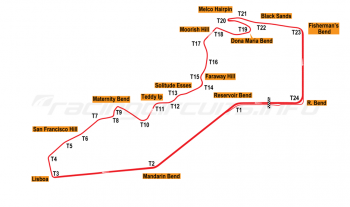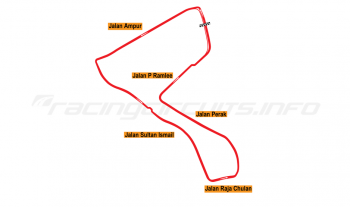Sepang
Circuit Overview
The Sepang International Circuit (Malay: Litar Antarabangsa Sepang) can well lay claim to setting the template that all modern Grand Prix circuits have followed in the 21st century.
Opening in 1998 ahead of its first season of racing, the track that was built especially for Formula One held the Malaysian Grand Prix for 19 seasons before electing to concentrate it's top class efforts on two-wheeled sports. It remains the home of the Malaysian MotoGP and is an extremely popular fixture on the calendar.
Known for its unpredictable humid tropical weather, varying from clear furnace hot days to tropical rain storms, the track has been extensively resurfaced in recent years to try and avoid the worst of the track flooding which marred some past events.
The track can be used in up two three configurations, the two shorter of which can be run simultaneously.
Circuit History
The brainchild of then-Prime Minister Dr President Mahathir Mohamad, Sepang International Circuit formed a central part of plans to transform Malaysia into an industrialised nation. To link the national capital with its international airport, a 'Multimedia Super Corridor' was planned, complete with two 'intelligent' cities featuring buildings linked by fibre optic cable networks and an integrated transportation system. The new Formula One-standard circuit would complete the project and set new standards in circuit design.
German architect Hermann Tilke, who had won previous favour with his redesign of the Österreichring into the shortened A1-Ring (now Red Bull Ring), was chosen to draw up the plans. For his first ground-up effort, Tilke penned a fast and flowing circuit which was dominated by two long straights separated by a unique main grandstand and central fan zone. Inspiration was drawn from the local surroundings in the design, with grandstands covered with canopies shaped like the leaves of the palm oil trees that fill the plantation on which the track was built.
The track features 15 corners and eight straights with a minimum width of 16 meters but rising to 20 meters in some areas, providing a number of good overtaking opportunities. In total, the track can accommodate some 130,000 spectators, with 30,000 in the unique double-fronted main grandstand.
Work began in December 1996, with the entire construction taking 14 months and costing RM286 million (US $12 million). At times, there were well over 1,000 people working on the site. The new circuit was completed in November 1998, hosted its first race the following month before an official inauguration by Dr Mahathir in March 1999.
World leading facility
Even before its completion it was being hailed as the best circuit in the world, thanks to the massive government investment and class-leading facilities. The circuit is covered by 27 closed circuit TV cameras via fibre optic cabling and includes on-line, real time tracking of race cars, combined with electronic marshal posts which will flash coloured lights to the drivers instead of flags. The two storey pit building houses all the main facilities. There are 30 pits, including an office, kitchen area and a conference area. Upstairs are 12 offices for the FIA and administration, plus race control, time keeping, media centre and interview room plus photographers' room. There is also a medical centre including a small operating theatre to handle minor surgery.
The government investment soon paid off, with the track licensed for top level racing by both the FIA and FIM, leading to the awarding of Formula One and Motorcycle Grand Prix events from 1999 onwards. Other major events include an annual 12-hour race for GT cars and occasional visits by the Japanese Super GT series.
It was clear from the very first races that the circuit promoted good close racing and was popular with drivers, drawing favourable comment from both the F1 and MotoGP paddocks.
"Sepang is a very special place - it’s not a stop-start circuit; it’s a flowing, high-speed track which is all about getting the car to flow from one corner to the next".
The circuit is tough on tires, however, because of the wide range of corners and the hard braking at the end of the straights - accounting for 17% of the full lap. Moreover, the track temperature often reaches 60 degrees Celsius, or 140 degrees Fahrenheit, which is also difficult for both car and driver. Seasonal downpours of rain have also created their own hazards, including the early termination of the 2009 event when monsoon rains made driving impossible.
Despite its auspicious start and lavish early funding, government interest in the facility waned slightly to the extent that by 2010 it had - according to Bernie Ecclestone - become "like an old house that needs a bit of redecorating." Harsh words for a circuit that was still far superior to more than a handful on the F1 calendar...
Some general improvements to paddock and spectator facilities have since been approved and the circuit was extensively resurfaced in 2016 by Dromo srl, the Italian circuit consultancy. The new surface was designed to have additional grip in wet weather running, while several run-off areas were also upgraded. The major change came with the re-configuration of the final turn, which retained its original layout but was re-profiled to became an off-camber curve, partly to encourage different racing lines being used. It was not universally popular with riders or drivers, but did make a major difference to drainage - an important factor given the monsoon-like downpours the circuit often experiences.
Ironically, the changes came as Sepang's bosses were in the process of falling out of love with F1. With the constant escalation in hosting fees and reducing audience sizes, the decision was taken not to renew the contract, so 2017's event, won by Max Verstappen, would prove to be the last for the foreseeable future. Instead, the circuit is focussing on its MotoGP and World Superbike events, which continue to prove to be very popular events.
During 2020 the circuit elected to let its FIA Grade One certification lapse, although this was largely due to the coronavirus pandemic and could be re-certified in future.
Jump onboard
Circuit info
- Sepang International Circuit Sdn. Bhd., Jalan Pekeliling, 64000 KLIA, Selangor, Darul Ehsan, Malaysia
- +60 1 2755 5731
- Email the circuit
- Official website
Rate This Circuit
Votes: 5499
Plan a visit
Get your race tickets!
Brought to you with: 
We've teamed up with Motorsports Tickets to bring you the best deals for Formula One, MotoGP, Le Mans and more.












